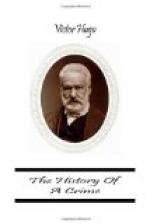And, in reference to this design, when the accomplices of the coup d’etat considered that the people in order to summon the High Court to do its duty, could invade the Palace of Justice, and that they would never look for it where it was assembled, they felt that this room had been excellently chosen. When, however, they considered that the police would also doubtless come to expel the High Court, and that perhaps they would not succeed in finding it, each one regretted to himself the choice of the room. They wished to hide the High Court, they had succeeded too well. It was grievous to think that perhaps when the police and the armed force should arrive, matters would have gone too far, and the High Court would be too deeply compromised.
They had appointed a Recorder, now they must organize a Court. A second step, more serious than the first.
The judges delayed, hoping that fortune would end by deciding on one side or the other, either for the Assembly or for the President, either against the coup d’etat or for it, and that there might thus be a vanquished party, so that the High Court could then with all safety lay its hands upon somebody.
They lengthily argued the question, whether they should immediately decree the accusation of the President, or whether they should draw up a simple order of inquiry. The latter course was adopted.
They drew up a judgment, not the honest and outspoken judgment which was placarded by the efforts of the Representatives of the Left and published, in which are found these words of bad taste, Crime and High Treason; this judgment, a weapon of war, has never existed otherwise than as a projectile. Wisdom in a judge sometimes consists in drawing up a judgment which is not one, one of those judgments which has no binding force, in which everything is conditional; in which no one is incriminated, and nothing, is called by its right name. There are species of intermediate courses which allow of waiting and seeing; in delicate crises men who are in earnest must not inconsiderately mingle with possible events that bluntness which is called Justice. The High Court took advantage of this, it drew up a prudent judgment; this judgment is not known; it is published here for the first time. Here it is. It is a masterpiece of equivocal style:—
EXTRACT FROM THE REGISTRY OF THE HIGH COURT OF JUSTICE.
“The High Court of Justice.
“According to Article 68 of the Constitution, considering that printed placards beginning with these words, ’The President of the Republic’ and ending with the signatures, ‘Louis Napoleon Bonaparte’ and ‘De Morny, Minister of the Interior,’ the said placards ordaining amongst other measures the dissolution of the National Assembly, have been posted to-day on the walls of Paris, that this fact of the dissolution of the National Assembly by the President of the Republic would be of the nature to constitute the case provided




